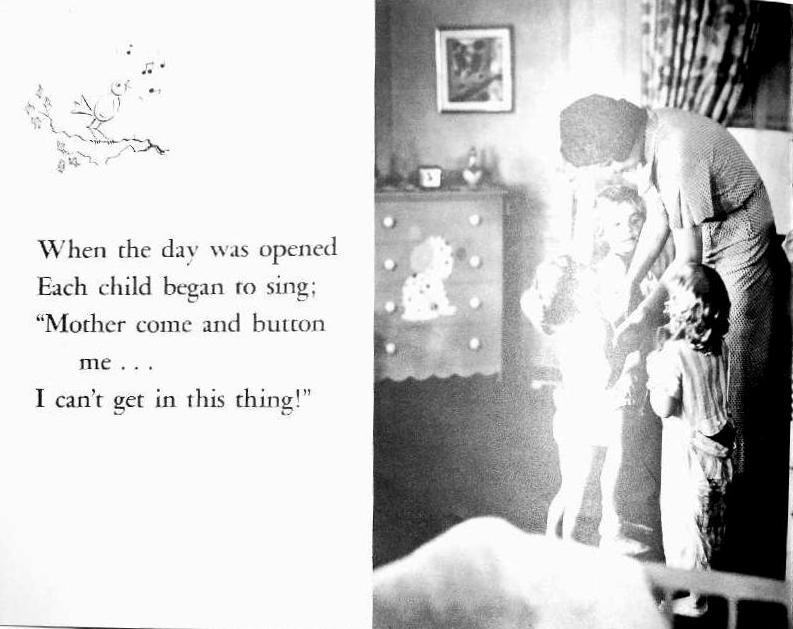
Clothing Closures: Zippers

Figure 1.--This is a story book from the Hub, a Baltimore clothing store, about new clothing without buttons. The Hub distributed the booklet in 1934 to mothers, promoting clothes made with zippers rather than buttons as a way of making it easier for younger children to dress themselves. The no more buttons page shows children struggling with buttons. The story book was part of a promotion of clothing using Talon Zippers. Talon was of course the major manufacturwr of zippers. Apparently Talon also sponsored a movie of the same name.
|
|
Zippers are a modern innovation. They were developed in the 1890s, but did not become widely accepted for clothing until well into the 20th century. They are rarely thought of today, but they are used on a wide range of clothes for both children and adults. Zippers are most commonly employed on jackets and pants. Some of the earliest users were on shoes, replacing the buttons common at the turn of the century. The original zippers were made of metal. Some of the early models rusted after only a brief period. Other types of zippers began to appear in the 1970s. Zippers are still made of metal, but they are also made of polyester, nylon, plastic, acrylic, ABS and different combination of materials. Polyester and plastic zippers are now more common than the metal ones. Zippers are used for both children and adult clothing. The only eception here is the very young. Zippers are not commonly worn on either infant and toddler clothing. This is because the zipper is a little tricky for young children to handle. Buttons were easier for young children just learning to dress themselves.
Historical Background
The clasp-locker
The zipper called the "clasp-locker" appeared in the 1890s. It was one of many wonderful innovations which appeared at the Chicago World Fair. About
21 million people flocked to Chicago in 1893 to behold the wonders
displayed at the World's Fair. The very first electric Ferris Wheel rotated high above the fair grounds, while the scandalous Coochie-Coochie belly dancer "Little Egypt" rotated below. Vanishing behind this perfervid activity was a modest booth displaying a device called a "clasp-locker." An engineer named Whitcomb Judson had patented this item August 29, 1893. He intended it to replace the hook and eye shoelaces so prevalant in the late 19th century. The "clasp-locker" device resembled two small chains of alternating hook and eye locks. A metal sliding implement joined the two chains, which then closed the shoe flaps to which they were attached. Whitcomb Judson's idea was pratical but pale in the shadow of Little Egypt and the electricity which drove the 1893 Ferris Wheel. Few came to gawk at Judson's discrete invention.
Judson's invention was not an immediate success. As common as they are today, it is interesting that no one at first wanted anything to do with them. In fact, Judson sold only 20 at the Fair and not many afterwards. Early versions were not very reliable. Men in particular viewed them with suspcion. Many men view the zipper with some trepidation, prefering the saftey of buttons. Some people couldn't even figure out how to work it. Early versions actually came with directions!
Clasp-lockers
Another engineer, Gideon Sundback, about 15 years later modified
Judson's idea. He manufactured a smaller, lighter version of the
"clasp-locker." Renamed "hookless fastener,"
this device could be attached not only to boots, but also to clothing and
purses. Early versiions would rust tight afteronly a few washings.
Goodrich and zippers
Finally Sundback found an enthusiastic buyer. It was the B. F. Goodrich Company, in 1923, that began popularized the zipper. The company presented a rubber overboot to the
public called galoshes. They were equipped with reliable a "hookless fastener," only on this new footwear it was called a "zipper." Until this point, they were called hookless fasteners. B.F. Goodrich liked the z-z-zip sound they made and coined the
term. The story goes that Mr. B. F. Goodrich himself invented the word zipper
in imitation of its sound. It appears, however, that the onomatopoeic
term "zip" had been lurking in the English language since at least 1850, but the B. F. Goodrich product made it a household word.
Clothing
The zipper began appearing on jackets and other garments in the 1920s. It began it began replacing buttons as fastners on men and boys' trousers in the 1930s. This was not an instant success. The ziper did not begin to become fully accepted until the 1950s and even then better quality trousers for a gtime were were made with buttons. The zipper begame universally accepted by the 1960s.
Material
The original zippers were made of metal. Some of the early models rusted after only a brief period. Other types of zippers began to appear in the 1970s. Zippers are still made of metal, but they are also made of polyester, nylon, plastic, acrylic, ABS and different combination of materials. Polyester and plastic zippers are now more common than the metal ones.
Age
Zippers are used for both children and adult clothing. The only eception here is the very young. Zippers are not commonly worn on either infant and toddler clothing. This is because the zipper is a little tricky for young children to handle. Buttons were easier for young children just learning to dress themselves.
Sources
HBC

Navigate the Boys' Historical Clothing Web Site:
[Return to the Main closener page]
[Introduction]
[Activities]
[Biographies]
[Chronology]
[Cloth and textiles]
[Clothing styles]
[Countries]
[Topics]
[Bibliographies]
[Contributions]
[FAQs]
[Glossaries]
[Images]
[Images]
[Links]
[Registration]
[Tools]
[Boys' Clothing Home]
Created: January 25, 1999
Last updated: 7:32 PM 7/25/2011



